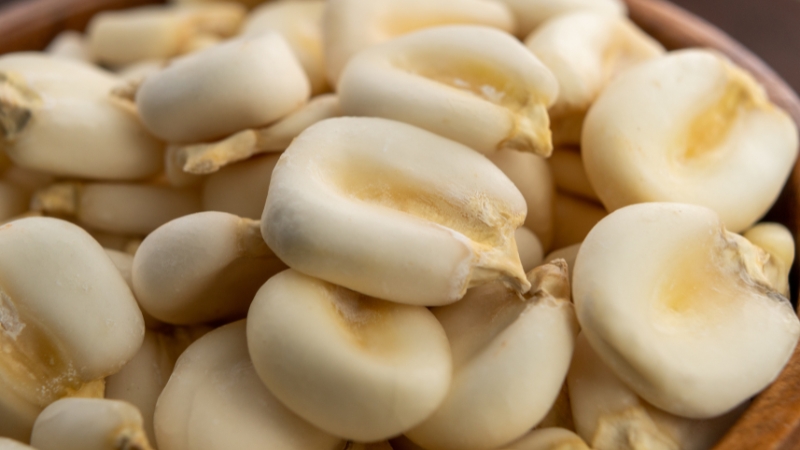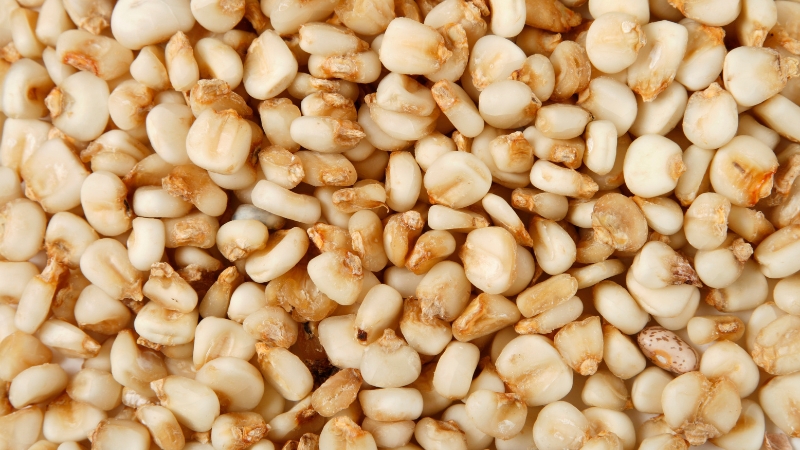Hominy is made from dried corn kernels that have undergone a traditional process called nixtamalization. This is a method used for thousands of years by Indigenous communities in Central and North America, especially the Aztecs and Mayans.
In this process, corn is soaked and cooked in an alkaline solution (usually limewater or lye), which loosens the hull and softens the kernels. The result is a puffy, chewy, slightly nutty kernel with a mild flavor and a ton of culinary potential.
Nixtamalization isn’t just about texture—it chemically alters the corn to make nutrients more available to the body.
This process is what separates hominy from just plain corn. It’s the base for masa (used in tortillas and tamales), but when left whole, it becomes the star of hearty dishes like posole, succotash, and modern grain bowls.
Nutritional Breakdown

Let’s get into the numbers. One cup of canned white hominy (drained) contains approximately:
On the surface, hominy looks like a relatively basic carb. But there’s more here than meets the eye. Thanks to nixtamalization, hominy becomes a better source of niacin (vitamin B3), a nutrient that plain corn lacks in absorbable form.
Without nixtamalization, a corn-heavy diet can lead to niacin deficiency—a condition known as pellagra. That’s why this traditional method of preparing corn isn’t just cultural—it’s nutritional science in action.
Hominy is also naturally gluten-free, which makes it a great option for people with celiac disease or gluten sensitivity who want a hearty, grain-like texture in their meals.
So, Is It Healthy?
Yes—hominy can absolutely be part of a healthy diet, especially when used in place of more processed or refined grains. It offers complex carbohydrates, fiber to support digestion, and a lower glycemic index compared to white rice or pasta. It’s also relatively low in calories, making it a smart base for nutrient-dense meals.
That said, the healthiness of hominy depends on how you prepare and serve it. If you’re tossing it into a vegetable-heavy soup or pairing it with lean proteins and healthy fats, great. If you’re eating it in high-fat, sodium-heavy stews or fried dishes, then its nutritional halo might dim a bit.
What Does Science Say?
Studies support the benefits of nixtamalization in improving the safety and nutritional value of corn. A 2021 study published in Food Chemistry found that nixtamalization reduces harmful mycotoxins, like aflatoxins, by up to 94%, making the resulting product not only more nutritious but also safer to consume.
Another study from the Journal of Agricultural and Food Chemistry confirmed that this ancient technique significantly increases calcium availability in corn and improves protein digestibility.
So, while hominy may look like just another starchy filler, it’s actually a product of food science and traditional wisdom coming together.
How Does It Compare to Other Grains?
Here’s a quick comparison between 1 cup servings of cooked hominy, brown rice, and quinoa:
Nutrient
Hominy
Brown Rice
Quinoa
Calories
120
215
222
Protein (g)
2.5
5
8
Fiber (g)
4
3.5
5
Fat (g)
1.5
1.6
3.6
Gluten-Free
Yes
Yes
Yes
As you can see, quinoa is the most protein-packed of the three, but hominy holds its own in terms of fiber and calorie control.
For those who prefer a milder taste and chewy texture, hominy can be a great middle-ground option.
Best Ways to Cook and Serve Hominy
View this post on Instagram
Hominy is incredibly versatile, and once you’ve tasted it, it’s easy to fall in love. It can be:
- Simmered in soups like posole with shredded pork or chicken, green chiles, and lime
- Added to chili or bean stews for extra texture and heartiness
- Roasted or sautéed with herbs and garlic for a savory side dish
- Tossed in salads or grain bowls with roasted vegetables and tahini dressing
- Mashed or blended into dips (think hominy hummus or cheesy mash)
If you want to try something new for breakfast, you can even warm up hominy with a splash of almond milk, cinnamon, and a drizzle of honey for a savory-sweet porridge-style dish.
What to Pair With Hominy
Looking to build a balanced meal around hominy? Try these combinations:
Dish
Pairing Suggestions
Hominy & Veggie Stew
Top with avocado slices, fresh cilantro, and a squeeze of lime
Posole (Red or Green)
Add shredded chicken or pork, thinly sliced radish, lime wedges, and shredded cabbage
Roasted Hominy Side
Serve with grilled salmon, sautéed kale, and lemony tahini sauce
Hominy Salad Bowl
Toss with black beans, corn, sweet potato, red onion, and chipotle-lime yogurt dressing
Breakfast Hominy Porridge
Top with banana, cinnamon, toasted walnuts, and a spoon of almond butter
Hominy Tacos or Wraps
Use with grilled mushrooms, cotija cheese, and pickled onions in corn tortillas
Hominy Stir-Fry
Combine with broccoli, bell peppers, tofu, and a light soy-ginger glaze
Southern-Style Hominy Grits
Pair with sautéed shrimp, garlic butter, and green onions
Hominy Chili
Mix with ground turkey or beans, top with sour cream and jalapeños
Hominy and Egg Breakfast Hash
Fry with potatoes, bell peppers, and serve with poached eggs and salsa verde
Hominy Buddha Bowl
Layer with quinoa, roasted chickpeas, beet hummus, and arugula
Hominy Patties or Fritters
Serve with tzatziki or avocado crema for dipping
Creamy Hominy Bake
Mix with cheese, diced chiles, and bake for a comforting casserole-style side
Hominy & Tomato Soup
Add white beans and kale for a simple yet nourishing lunch
Hominy’s subtle flavor makes it a flexible ingredient that pairs well with both savory and slightly sweet elements.
Any Drawbacks?
There are only a couple of things to watch for. Canned hominy can be high in sodium, so if you’re buying it pre-cooked, it’s smart to rinse it well before cooking or look for low-sodium options.
@you_can_whip_it #hominy #hominycorn #whitehominy #airfried #airfryer #cornnuts #cornnut #airfriedcorn #airfriedrecipes #airfryerrecipes #fyp #foodtok #foodtiktok #cannedfood #mexicanstyle #mexicantiktok #corn #cornrecipe #airfryermaster #snacks #airfriedsnacks #easyrecipe #chickahominy ♬ For Latin American videos such as Mexican food – RYOpianoforte
Dried hominy requires soaking and longer cook times, but many say the flavor and texture payoff is worth it.
And while hominy is healthier than many assume, it’s not a miracle food. It should be part of a diverse diet filled with vegetables, lean proteins, healthy fats, and whole grains.
Final Verdict
Hominy is far more than just a trendy filler. It’s a nutritionally sound, culturally rich food that’s been around for millennia.
Whether you’re looking for a new gluten-free grain, a way to shake up your weeknight dinners, or simply love trying traditional ingredients with a modern twist, hominy deserves a spot on your table.
In fact, pairing hominy with some of the spiciest foods in the world can elevate its flavor and give your dishes an exciting edge.
With its fiber, its improved nutrient bioavailability from nixtamalization, and its easy-to-cook format, hominy is more than a side dish—it’s a conversation between the past and present.

